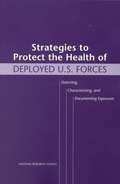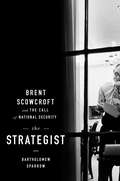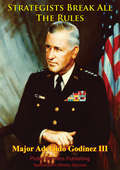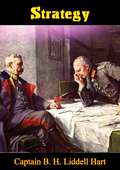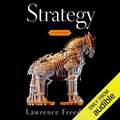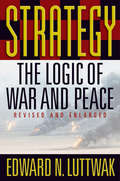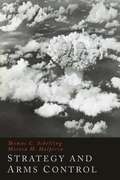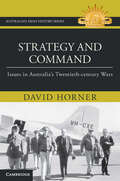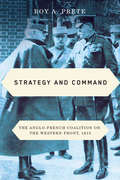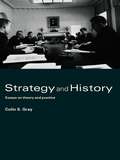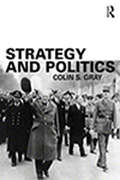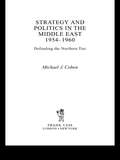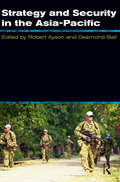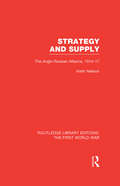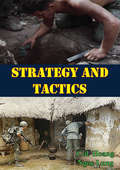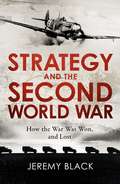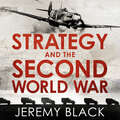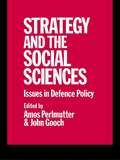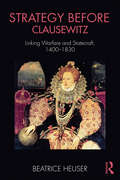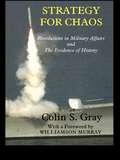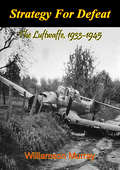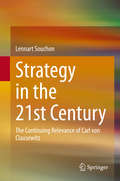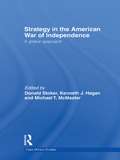- Table View
- List View
Strategies of Containment: A Critical Appraisal of American National Security Policy During the Cold War (Revised and Expanded Edition)
by John Lewis GaddisWhen Strategies of Containment was first published, the Soviet Union was still a superpower, Ronald Reagan was president of the United States, and the Berlin Wall was still standing. This updated edition of Gaddis' classic carries the history of containment through the end of the Cold War. Beginning with Franklin D. Roosevelt's postwar plans, Gaddis provides a thorough critical analysis of George F. Kennan's original strategy of containment, NSC-68, The Eisenhower-Dulles "New Look," the Kennedy-Johnson "flexible response" strategy, the Nixon-Kissinger strategy of detente, and now a comprehensive assessment of how Reagan-- and Gorbachev-- completed the process of containment, thereby bringing the Cold War to an end. He concludes, provocatively, that Reagan more effectively than any other Cold War president drew upon the strengths of both approaches while avoiding their weaknesses. A must-read for anyone interested in Cold War history, grand strategy, and the origins of the post-Cold War world.
Strategies to Protect the Health of Deployed U.S. Forces: Detecting, Characterizing, and Documenting Exposures
by Strategies to Protect the Health of Deployed U.S. Forces: Technology Methods For Detection Tracking of Exposures to a Subset of Harmful AgentsA report on Detecting, Characterizing, and Documenting Exposures
The Strategist: Brent Scowcroft and the Call of National Security
by Bartholomew SparrowBased on the full cooperation of the subject--with no restraining conditions--The Strategist provides an in-depth portrait of a man whose career has been intimately linked to the great transformations in U. S. foreign policy, from the last third of the Cold War, to September 11, 2001, and up to the present. Bartholomew Sparrow brings color and focus to the complex and often secretive nature of U. S. foreign policy and strategic adjustments--an intellectual battlefield on which ideas and worldviews clash, in which economics, politics, and strategic concerns intertwine, and in which private citizens and non-office holders may exert as much influence as highly visible Cabinet officials. Among the most important foreign policy minds of the 20th and early 21st centuries, Brent Scowcroft is also among the least well-known or understood. In a now-famous August 2002 Wall Street Journal op-ed titled "Don’t Attack Saddam Hussein,” Brent Scowcroft, who had been national security advisor under President George H. W. Bush, went to war himself, in a sense, with his closest and longest-standing friends. He noted the scant evidence that tied the Iraqi government to terrorist organizations. He warned that an invasion and occupation of Iraq would be costly and potentially disastrous for a variety of carefully considered reasons. He recommended that the Bush administration work with the U. N. Security Council and wait for definitive proof of Saddam’s wrongdoing before taking action. The essay at once made Scowcroft the most outspoken and most credible critic of the Bush administration’s plans for war and immediately generated national controversy. It provoked a sudden, deep split in the Republican Party over the plans for war. Vice President Cheney, National Security Advisor Rice, Defense Secretary Rumsfeld, and President George W. Bush all vigorously reaffirmed their cause and their course of action, and the media and American public opinion soon fell in line. Clearly, Scowcroft, 84, continues to participate in the most central and important debates over U. S. foreign policy and national security. He has been a leading architect of U. S. foreign policy and grand strategy for almost a half-century, and though long out of office, still gives speeches, makes media appearances, and leads tasks forces and commissions. He is a rare creature, one of the few "wise men” of the nation’s capital: someone who is regularly consulted by top government officials in Democratic and Republican administrations, ranking members of the House and Senate from both sides of the aisle, and the country’s leading foreign-policy journalists. As recently as April 2009, Scowcroft co-chaired an extensive Council of Foreign Relations study of the U. S. nuclear weapons policy. More than anyone else, he stands at the center of the United States’ foreign policy establishment. Most significantly, Scowcroft is trusted--a scarce and typically fleeting quality in Washington--and has been for four decades. The unprecedented insights into the man and his career Sparrow offers in The Strategist are vital to anyone who wishes to understand America's changing role in the world.
Strategists Break All The Rules
by Major Adelaido Godinez IIIEmory Upton believed that politicians should leave war to professionals. This led to two assumptions that became conventional wisdom: first, an apolitical army represented a more professional force; and second, the problems at the tactical and operational level were similar enough to be useful in developing strategic thinking. These assumptions resulted in what Samuel P. Huntington described as the "normal-theory" relationship between policy-makers and generals. The assumption made sense for the United States but had one unfortunate result. The Army as an institution misread the nature of an apolitical force. The essence of an apolitical force should be non-partisan -Army professionals above political interference or interest. There is a difference, however, between policy and politics. While not involving itself in the political life of the nation, the Army is vitally concerned with the policies of the nation. The discussion strategists must prepare for are political, but in the nature of policy as the object of war. A historical survey of strategists from General Winfield Scott to General Creighton Abrams suggests that the most successful strategists are life-long learners. They build holistic understanding of the interdependent and infinite connections of the whole problem. Once they develop a hypothesis about the whole problem, they reshape those connections to create a better peace for the United States. Strategists that take time to understand the whole problem encourage discourse. Retaining the Functional Area 59 Strategist program will continue to benefit the force because they do not follow a traditional route to generalship. After all, few have earned stars by arguing, debating, and taking intellectual risk.
Strategy
by Captain B. H. Liddell HartThis is the classic book on war as we know it. During his long life, Basil H. Liddell Hart was considered one of the world's foremost military thinkers--a man generally regarded as the "Clausewitz of the 20th century." Strategy is a seminal work of military history and theory, a perfect companion to Sun-tzu's The Art of War and Carl von Clausewitz's On War.Liddell Hart stressed movement, flexibility, and surprise. He saw that in most military campaigns dislocation of the enemy's psychological and physical balance is prelude to victory. This dislocation results from a strategic indirect approach. Reflect for a moment on the results of direct confrontation (trench war in WWI) versus indirect dislocation (Blitzkrieg in WWII). Liddell Hart is also tonic for business and political planning: just change the vocabulary and his concepts fit.-Print ed."The most important book by one of the outstanding military authorities of our time."--Library Journal
Strategy: A History
by Lawrence FreedmanIn Strategy: A History, Sir Lawrence Freedman, one of the world's leading authorities on war and international politics, captures the vast history of strategic thinking, in a consistently engaging and insightful account of how strategy came to pervade every aspect of our lives. <p><p> The range of Freedman's narrative is extraordinary, moving from the surprisingly advanced strategy practiced in primate groups, to the opposing strategies of Achilles and Odysseus in The Iliad, the strategic advice of Sun Tzu and Machiavelli, the great military innovations of Baron Henri de Jomini and Carl von Clausewitz, the grounding of revolutionary strategy in class struggles by Marx, the insights into corporate strategy found in Peter Drucker and Alfred Sloan, and the contributions of the leading social scientists working on strategy today. The core issue at the heart of strategy, the author notes, is whether it is possible to manipulate and shape our environment rather than simply become the victim of forces beyond one's control. <p><p> Time and again, Freedman demonstrates that the inherent unpredictability of this environment - subject to chance events, the efforts of opponents, the missteps of friends - provides strategy with its challenge and its drama. Armies or corporations or nations rarely move from one predictable state of affairs to another, but instead feel their way through a series of states, each one not quite what was anticipated, requiring a reappraisal of the original strategy, including its ultimate objective. Thus the picture of strategy that emerges in this book is one that is fluid and flexible, governed by the starting point, not the end point. A brilliant overview of the most prominent strategic theories in history, from David's use of deception against Goliath, to the modern use of game theory in economics, this masterful volume sums up a lifetime of reflection on strategy.
Strategy: The Logic of War and Peace, Revised and Enlarged Edition
by Edward N. Luttwak“If you want peace, prepare for war.” “A buildup of offensive weapons can be purely defensive.” “The worst road may be the best route to battle.” Strategy is made of such seemingly self-contradictory propositions, Edward Luttwak shows—they exemplify the paradoxical logic that pervades the entire realm of conflict. In this widely acclaimed work, now revised and expanded, Luttwak unveils the peculiar logic of strategy level by level, from grand strategy down to combat tactics. Having participated in its planning, Luttwak examines the role of air power in the 1991 Gulf War, then detects the emergence of “post-heroic” war in Kosovo in 1999—an American war in which not a single American soldier was killed. In the tradition of Carl von Clausewitz, Strategy goes beyond paradox to expose the dynamics of reversal at work in the crucible of conflict. As victory is turned into defeat by over-extension, as war brings peace by exhaustion, ordinary linear logic is overthrown. Citing examples from ancient Rome to our own days, from Barbarossa and Pearl Harbor down to minor combat affrays, from the strategy of peace to the latest operational methods of war, this book by one of the world’s foremost authorities reveals the ultimate logic of military failure and success, of war and peace.
Strategy and Arms Control
by Thomas C. Schelling Morton H. HalperinThis study is an attempt to identify the meaning of arms control in the post war period. It presents an analysis of arms control with particular emphasis on the military policy involved. The general objectives of the study is to advance some aspects of the intellectual state of the art in arms control and to provide some concrete data on the technical and strategic problems of importance.
Strategy and Command: Issues in Australia's Twentieth-century Wars (Australian Army History Series)
by David HornerIn Strategy and Command, David Horner provides an important insight into the strategic decisions and military commanders who shaped Australia's army history from the Boer War to the evolution of the command structure for the Australian Defence Force in the 2000s. He examines strategic decisions such as whether to go to war, the nature of the forces to be committed to the war, where the forces should be deployed and when to reduce the Australian commitment. The book also recounts decisions made by commanders at the highest level, which are passed on to those at the operational level, who are then required to produce their own plans to achieve the government's aims through military operations. Strategy and Command is a compilation of research and writing on military history by one of Australia's pre-eminent military historians. It is a crucial read for anyone interested in Australia's involvement in 20th-century wars.
Strategy and Command: The Anglo-French Coalition on the Western Front, 1915
by Roy A. PreteFalling between the “War of Movement” in 1914 and the major attrition battles of 1916, 1915 was a critical year in the First World War. As France failed in ever-larger offensives to break through the German trenches, Britain shifted its strategy from defence of empire to total commitment to the continental war.In the second of three planned volumes, Roy Prete analyzes the political and military policies and strategies of Britain and France and their joint command relationship on the Western Front in 1915. The opposing strategies of the two governments proved to be the main determinant in the sometimes ragged relations between the French commander-in-chief, Joseph Joffre, and his British counterpart, Sir John French, as they sought to drive the German army out of France and to aid their hard-pressed Russian ally. With an impressive marshalling of evidence, Strategy and Command demonstrates that the increased British commitment to the continental war, manifested in sending Kitchener’s New Armies to France in 1915, was largely due to the disastrous situation of the Russian army on the Eastern Front and the perceived weakness of the French government.Based on extensive research in French and British political and military archives, this new in-depth study of Anglo-French military relations on the Western Front in 1915 fills a major gap in the unfolding drama of the First World War.
Strategy and History: Essays on Theory and Practice (Strategy and History)
by Colin S. GrayStrategy and History comprises a selection of Professor Gray's key contributions to strategic debate over the past thirty years. These essays have been selected both because they had significant messages for contemporary controversies, and because they have some continuing relevance for today and the future. Each essay in this book is really about strategy in the modern world, and reflects the many dimensions of this complex subject. This book covers a wide range of subjects and historical events, but there are key issues covered throughout: being strategic the consequences of actions a respect for Clausewitz’s theory of war historical dependency the importance of geography being critical of enthusiasm for technology over human factors the primacy of politics. This important publication provides an invaluable insight into the development of strategic studies over the past 30 years from one of the world's leading theorists and practitioners of the subject. The book will be of great interest to all students and analysts of strategy and international studies.
Strategy and Politics
by Colin S. GrayThis book examines the subject of strategy and its relationship with politics. Despite the fact that strategy is always the product of political process, the relationship between the two concepts and their ancillary activities has scarcely been touched by scholars. This book corrects that serious deficiency, and explains the high relevance of political factors for matters of general defence. Each chapter aims to show how and why strategy and politics interact and how this interaction has had significant consequences historically. Neither strategy nor politics can make sense if considered alone. Strategy requires direction that can only be provided by political process, while politics cannot be implemented without strategy. In summary, this volume will explain: what strategy is (and is not) why strategy is essential what strategy does and how it does it how strategy is made and executed Written by a leading scholar and former practitioner, this book will be essential reading for all students of military strategy, strategic studies, security studies and war and conflict studies.
Strategy and Politics in the Middle East, 1954-1960: Defending the Northern Tier
by Michael CohenThe period covered by this book witnessed a significant change in Allied strategy for the Middle East. Its focus switched from Egypt to the states of the so-called northern tier of the Middle East: Turkey, Iraq, Iran and Pakistan. This book reveals the extent to which the UK clung on to great-power pretensions and used bluff, even deception, in order to give the impression that it disposed of greater military resources than was in fact the case. It describes not only Anglo-American tensions in the Middle East, but also the Americans' reluctance to take over Britain's former hegemony in the region. Finally, it reveals the extent to which the Allies' relationship with Israel was a constant restraint upon their freedom of action in the area, and their ability to forge military alliances with Arab states.
Strategy and Security in the Asia-Pacific: Global and regional dynamics (Canberra Papers On Strategy And Defence #No. 139)
by Robert Ayson Desmond BallFrom the war on terror to the rise of China, this book unlocks the major strategic themes and security challenges of the early twenty-first century. Strategy and Security in the Asia-Pacific provides the analytical frameworks needed to make sense of this complex but exciting strategic universe. Offering a unique mix of global strategic thinking and Asia-Pacific security analysis, this book is for readers from Sydney to Seoul who want to put their own local security challenges in a wider regional and global context. It is also for North American and European readers requiring an understanding of the dynamic security developments in the Asia-Pacific region around which so much of global strategy is increasingly based. The really vital questions facing the international community are dealt with here: Why do governments and groups still use armed force? Has warfare really changed in the information age? Why should we be concerned about non-traditional security challenges such as water shortages and the spread of infectious disease? Is a great clash imminent between the United States and China? What are the prospects for peace on the Korean peninsula and between India and Pakistan? Can Southeast Asia survive the challenges of transnational terrorism? What does security mean for the Pacific island countries and for Australia and New Zealand? With contributions from leading commentators and analysts, Strategy and Security in the Asia-Pacific offers a comprehensive and authoritative introduction to the field.
Strategy and Supply: The Anglo-Russian Alliance 1914-1917 (Routledge Library Editions: The First World War)
by Keith NeilsonBased on a wide range of primary sources, this book shows the way in which diplomacy, economics, finance and strategy became intertwined during the First World War. The author examines the diplomatic, economic, financial and military relations between Britain and Russia and argues that the key to understanding the alliance is the British determination to win the war and the role Russia played in achieving this aim. British strategy is shown to be more the result of her relations with her allies, especially during the first years of the war, than a quarrel between East and West. This revision of the accepted interpretation of the strategy leads to a reassessment of the views of Lloyd George, Kitchener and Grey. The author concludes that in 1917 the British interest in Russia remained as it was earlier in the war: the maintenance of a powerful ally on the eastern front.
Strategy and Tactics (Indochina Monographs #1)
by Col. Hoang Ngoc LungIncludes over 10 maps and illustrationsThis monograph forms part of the Indochina Monograph series written by senior military personnel from the former Army of the Republic of Vietnam who served against the northern communist invasion."During the war years, the Republic of Vietnam and the United States pursued a common goal; their armed forces fought against the same enemy, under the same campaign plan, with the same weapon systems, and in the same environment.The strategic approaches to fighting this war, however, evolved through several stages depending on the enemy's kind of warfare and force structure; so did the tactics designed to counter his large-unit and guerrilla activities. This monograph endeavors, therefore, to trace back and evaluate our strategic alternatives at each stage of the war and the evolving tactics employed, with particular emphasis on the period of American withdrawal and reduced support.In the preparation of this monograph, I have expressly confined my discussions of strategy to its military aspect. While this conforms to the limited scope of a military subject, the encompassing nature of strategy, especially one conceived to face the enemy's approach to total war, implies that for a better understanding of military strategy, the interplay of social, political, and economic factors should also be brought in as a backdrop. Therefore, wherever appropriate, I have found it necessary to place strategic discussions in the total war context."-Author's Introduction.
Strategy and the Second World War: How the War was Won, and Lost
by Jeremy BlackA concise, accessible account of strategy and the Second World War. How the war was won . . . and lost..In 1941, the Second World War became global, when Nazi Germany attacked the Soviet Union; Japan attacked the United States at Pearl Harbor; and Germany declared war on the United States.In this timely book, which fills a real gap, Black engages with the strategic issues of the time - as they developed chronologically, and interacted - and relates these to subsequent debates about the choices made, revealing their continued political resonances.Beginning with Appeasement and the Soviet-German pact as key strategic means, Black examines the consequences of the fall of France for the strategies of all the powers. He shows how Allied strategy-making was more effective at the Anglo-American level than with the Soviet Union, not only for ideological and political reasons, but also because the Americans and British had a better grasp of the global dimension.He explores how German and Japanese strategies evolved as the war went badly for the Axis powers, and discusses the extent to which seeking to mould the post-war world informed Allied strategic choices from 1943 onwards, and the role these played in post-war politics, notably in the Cold War. Strategy was a crucial tool not only for conducting the war; it remains the key to understanding it today.
Strategy and the Second World War: How the War was Won, and Lost
by Jeremy BlackA concise, accessible account of strategy and the Second World War. How the war was won . . . and lost..In 1941, the Second World War became global, when Nazi Germany attacked the Soviet Union; Japan attacked the United States at Pearl Harbor; and Germany declared war on the United States.In this timely book, which fills a real gap, Black engages with the strategic issues of the time - as they developed chronologically, and interacted - and relates these to subsequent debates about the choices made, revealing their continued political resonances.Beginning with Appeasement and the Soviet-German pact as key strategic means, Black examines the consequences of the fall of France for the strategies of all the powers. He shows how Allied strategy-making was more effective at the Anglo-American level than with the Soviet Union, not only for ideological and political reasons, but also because the Americans and British had a better grasp of the global dimension.He explores how German and Japanese strategies evolved as the war went badly for the Axis powers, and discusses the extent to which seeking to mould the post-war world informed Allied strategic choices from 1943 onwards, and the role these played in post-war politics, notably in the Cold War. Strategy was a crucial tool not only for conducting the war; it remains the key to understanding it today.
Strategy and the Second World War: How the War was Won, and Lost
by Jeremy BlackA concise, accessible account of strategy and the Second World War. How the war was won . . . and lost..In 1941, the Second World War became global, when Nazi Germany attacked the Soviet Union; Japan attacked the United States at Pearl Harbor; and Germany declared war on the United States.In this timely book, which fills a real gap, Black engages with the strategic issues of the time - as they developed chronologically, and interacted - and relates these to subsequent debates about the choices made, revealing their continued political resonances.Beginning with Appeasement and the Soviet-German pact as key strategic means, Black examines the consequences of the fall of France for the strategies of all the powers. He shows how Allied strategy-making was more effective at the Anglo-American level than with the Soviet Union, not only for ideological and political reasons, but also because the Americans and British had a better grasp of the global dimension.He explores how German and Japanese strategies evolved as the war went badly for the Axis powers, and discusses the extent to which seeking to mould the post-war world informed Allied strategic choices from 1943 onwards, and the role these played in post-war politics, notably in the Cold War. Strategy was a crucial tool not only for conducting the war; it remains the key to understanding it today.
Strategy and the Social Sciences: Issues in Defence Policy
by John Gooch Amos PerlmutterThis title available in eBook format. Click here for more information.Visit our eBookstore at: www.ebookstore.tandf.co.uk.
Strategy Before Clausewitz: Linking Warfare and Statecraft, 1400-1830 (Cass Military Studies)
by Beatrice HeuserThis collection of essays combines historical research with cutting-edge strategic analysis and makes a significant contribution to the study of the early history of strategic thinking. There is a debate as to whether strategy in its modern definition existed before Napoleon and Clausewitz. The case studies featured in this book show that strategic thinking did indeed exist before the last century, and that there was strategy making, even if there was no commonly agreed word for it. The volume uses a variety of approaches. First, it explores the strategy making of three monarchs whose biographers have claimed to have identified strategic reasoning in their warfare: Edward III of England, Philip II of Spain and Louis XIV of France. The book then analyses a number of famous strategic thinkers and practitioners, including Christine de Pizan, Lazarus Schwendi, Matthew Sutcliffe, Raimondo Montecuccoli and Count Guibert, concluding with the ideas that Clausewitz derived from other authors. Several chapters deal with reflections on naval strategy long thought not to have existed before the nineteenth century. Combining in-depth historical documentary research with strategic analysis, the book illustrates that despite social, economic, political, cultural and linguistic differences, our forebears connected warfare and the aims and considerations of statecraft just as we do today. This book will be of great interest to students of strategic history and theory, military history and IR in general.
Strategy for Chaos: Revolutions in Military Affairs and the Evidence of History (Strategy and History)
by Colin GrayIn this volume, Professor Colin Gray develops and applies the theory and scholarship on the allegedly historical practice of the 'Revolution in Military Affairs' (RMA), in order to improve our comprehension of how and why strategy 'works'.The author explores the RMA hypothesis both theoretically and historically. The book argues that the conduct of an RMA has to be examined as a form of strategic behaviour, which means that, of necessity, it must "work" as strategy works. The great RMA debate of the 1990s is reviewed empathetically, though sceptically, by the author, with every major school of thought allowed its day in court.The author presents three historical RMAs as case studies for his argument: those arguably revealed in the wars of the French Revolution and Napoleon; in World War I; and in the nuclear age. The focus of his analysis is how these grand RMAs functioned strategically. The conclusions that he draws from these empirical exercises are then applied to help us understand what, indeed, is - and what is not - happening with the much vaunted information-technology-led RMA of today.
Strategy For Defeat: The Luftwaffe, 1933-1945 [Illustrated Edition]
by Williamson MurrayIncludes the Aerial Warfare In Europe During World War II illustrations pack with over 200 maps, plans, and photos.This book is a comprehensive analysis of an air force, the Luftwaffe, in World War II. It follows the Germans from their prewar preparations to their final defeat. There are many disturbing parallels with our current situation. I urge every student of military science to read it carefully. The lessons of the nature of warfare and the application of airpower can provide the guidance to develop our fighting forces and employment concepts to meet the significant challenges we are certain to face in the future.
Strategy in the 21st Century: The Continuing Relevance of Carl von Clausewitz
by Lennart SouchonThis book presents a detailed discussion of Clausewitz's principal lines of thought and methods of implementation. It elaborates on his main objective of laying a foundation for the education of up-and-coming creative, knowledgeable and experienced future leaders. The book encourages reflection and study in strategic thinking in order to transform knowledge into genuine capability. The book explores the question of what a twenty-first-century decision-maker can learn from these strategic lines of thought. It bridges the gap between philosophical theory and strategic interaction in conflicts with an equal opponent. Readers learn to understand and employ the clash of wills, attack and defence, and friction, and in essence the necessary virtues of a strategic commander.The findings presented help to identify the essential features in complex decision-making situations and developing possible courses of strategic action from a holistic standpoint. As such, the book is a must read for strategists, business practitioners, and scholars of political leadership and management interested in a better understanding of strategy and decision-making.
Strategy in the American War of Independence: A Global Approach (Cass Military Studies)
by Kenneth J. Hagan Donald Stoker Michael T. McMasterThis book examines the strategies pursued by the Colonies and the other combatants in the American War for Independence, placing the conflict in its proper global context. Many do not realize the extent to which the 1775 colonial rebellion against British rule escalated into a global conflict. Collectively, this volume examines the strategies pursued by the American Colonies, Great Britain, France, Spain, and Holland, and the League of Armed Neutrality, placing the military, naval, and diplomatic elements of the struggle in their proper global context. Moreover, assessing how each nation prosecuted their respective wars provides lessons for current students of strategic studies and military and naval history. This book will be of great interest to students of strategic studies, American history, Military History and political science in general. Donald Stoker is Professor of Strategy and Policy for the US Naval War College’s Monterey Program in Monterey, California. He joined the Strategy and Policy faculty in 1999 and has taught both in Monterey and Newport. Kenneth J. Hagan, Professor Emeritus, the U.S. Naval Academy, is currently Professor of Strategy and Policy for the U.S. Naval War College’s Monterey Program. Michael T. McMaster is a Professor at the U.S. Naval War College in Monterey. He is a retired U.S. Navy Commander.

